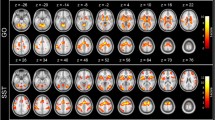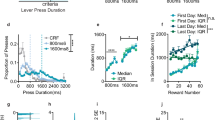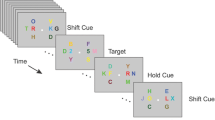Abstract
The study of intrapsychic conflict has long been central to many key theories about the control of behavior. More recently, by focusing on the nature of conflicting processes in the brain, investigators have revealed great insights about controlled versus automatic processes and the nature of self-control. Despite these advances, many theories of cognitive control or self-control remain agnostic about the function of subjective awareness (i.e., basic consciousness). Why people consciously experience some conflicts in the nervous system but not others remains a mystery. One hypothesis is that people become conscious only of conflicts involving competition for the control of skeletal muscle. To test one aspect of this larger hypothesis, in the present study, 14 participants were trained to introspect the feeling of conflict (the urge to make an error during a Stroop color-word interference task) and then were asked to introspect in the same way while sustaining simple compatible and incompatible intentions during fMRI scanning (to move a finger left or right). As predicted, merely sustaining incompatible skeletomotor intentions prior to their execution produced stronger systematic changes in subjective experience than sustaining compatible intentions, as indicated by self-report ratings obtained in the scanner. Similar ratings held for a modified Stroop-like task when contrasting incompatible versus compatible trials also during fMRI scanning. We use subjective ratings as the basis of parametric analyses of fMRI data, focusing a priori on the brain regions involved in action-related urges (e.g., parietal cortex) and cognitive control (e.g., dorsal anterior cingulate cortex, lateral PFC). The results showed that subjective conflict from sustaining incompatible intentions was consistently related to activity in the left post-central gyrus.





Similar content being viewed by others
References
Anderson AK, Phelps EA (2002) Is the human amygdala critical for the subjective experience of emotion? Evidence of intact dispositional affect in patients with amygdala lesions. J Cogn Neurosci 14:709–720
Baars BJ (2002) The conscious access hypothesis: origins and recent evidence. Trends Cogn Sci 6:47–52
Baddeley AD (2007) Working memory, thought, and action. Oxford Press, Oxford
Berti A, Pia L (2006) Understanding motor awareness through normal and pathological behavior. Curr Dir Psychol Sci 15:245–250
Block N (2007) Consciousness, accessibility, and the mesh between psychology and neuroscience. Behav Brain Sci 30:481–548
Botvinick M (2007) Conflict monitoring and decision making: reconciling two perspectives on anterior cingulate function. Cogn Affect Behav Neurosci 7:356–366
Botvinick MM, Braver TS, Carter CS, Barch DM, Cohen JD (2001) Conflict monitoring and cognitive control. Psychol Rev 108:624–652
Buchsbaum BR, D’Esposito M (2008) The search for the phonological store: from loop to convolution. J Cogn Neurosci 20:762–778
Bush G, Shin LM, Holmes J, Rosen BR, Vogt BA (2003) The multi-source interference task: validation study with fMRI in individual subjects. Mol Psychiatr 8:60–70
Chambon V, Wenke D, Fleming SM, Prinz W, Haggard P (2013) An online neural substrate for sense of agency. Cereb Cortex 23:1031–1037
Christensen MS, Lundbye-Jensen J, Geertsen SS, Petersen TH, Paulson OB, Nielsen JB (2007) Premotor cortex modulates somatosensory cortex during voluntary movements without proprioceptive feedback. Nat Neurosci 10:417–419
Cohen JD, Dunbar K, McClelland JL (1990) On the control of automatic processes: a parallel distributed processing account of the Stroop effect. Psychol Rev 97:332–361
Cohen JD, MacWhinney B, Flatt M, Provost J (1993) PsyScope: a new graphic interactive environment for designing psychology experiments. Behav Res Methods Instr Comput 25:257–271
Crick F (1995) The astonishing hypothesis: the scientific search for the soul. Touchstone, New York
Crick F, Koch C (2000) The unconscious homunculus. MIT, Cambridge
Curtis CE, D’Esposito M (2003) Success and failure suppressing reflexive behavior. J Cogn Neurosci 15:409–418
Curtis CE, D’Esposito M (2009) The inhibition of unwanted actions. In: Morsella E, Bargh JA, Gollwitzer PM (eds) Oxford handbook of human action. Oxford University Press, New York, pp 72–97
Dehaene S, Naccache L (2001) Towards a cognitive neuroscience of consciousness: basic evidence and a workspace framework. Cognition 79:1–37
Desmurget M, Sirigu A (2010) A parietal-premotor network for movement intention and motor awareness. Trends Cogn Sci 13:411–419
Desmurget M, Reilly KT, Richard N, Szathmari A, Mottolese C, Sirigu A (2009) Movement intention after parietal cortex stimulation in humans. Science 324:811–813
DeSoto MC, Fabiani M, Geary DC, Gratton G (2001) When in doubt, do it both ways: brain evidence of the simultaneous activation of conflicting motor responses in a spatial Stroop task. J Cogn Neurosci 13:523–536
Eidels A, Townsend JT, Algom D (2010) Comparing perception of Stroop stimuli in focused versus divided attention paradigms: evidence for dramatic processing differences. Cognition 114:129–150
Enger T, Hirsch J (2005) Cognitive control mechanisms resolve conflict through cortical amplification of task-relevant information. Nat Neurosci 8:1784–1790
Eriksen BA, Eriksen CW (1974) Effects of noise letters upon the identification of a target letter in a nonsearch task. Percept Psychophys 16:143–149
Eriksen CW, Schultz DW (1979) Information processing in visual search: a continuous flow conception and experimental results. Percept Psychophys 25:249–263
Etkin A, Prater KE, Hoeft F, Menon V, Schatzberg AF (2010) Failure of anterior cingulate activation and connectivity with the amygdala during implicit regulation of emotional processing in generalized anxiety disorder. Am J Psychiatry 167:545–554
Festinger L (1957) A theory of cognitive dissonance. Row Peterson, Evanston, IL
Freud S (1938) The basic writings of Sigmund Freud. Modern Library, New York
Fried I, Katz A, McCarthy G, Sass KJ, Williamson P, Spencer SS, Spencer DD (1991) Functional organization of human supplementary motor cortex studied by electrical stimulation. J Neurosci 11:3656–3666
Fuster JM (2003) Cortex and mind: unifying cognition. Oxford Press, New York
Gazzaley A, D’Esposito M (2007) Top-down modulation and normal aging. Ann NY Acad Sci 1097:67–83
Gazzaley A, Nobre AC (2011) Top-down modulation: bridging selective attention and working memory. Trends Cogn Sci 16:129–135
Gazzaley A, Cooney JW, Rissman J, D’Esposito M (2005) Top-down suppression deficit underlies working memory impairment in normal aging. Nat Neurosci 8:1298–1300
Godwin CA, Gazzaley A, Morsella E (in press) Homing in on the brain mechanisms linked to consciousness: Buffer of the perception-and-action interface. In: Pereira A, Lehmann D (eds) The unity of mind, brain and world: current perspectives on a science of consciousness. Cambridge Press, Cambridge
Goodale M, Milner D (2004) Sight unseen: an exploration of conscious and unconscious vision. Oxford Press, Oxford
Gray JA (1995) The contents of consciousness: a neuropsychological conjecture. Behav Brain Sci 18:659–676
Gray JA (2004) Consciousness: creeping up on the hard problem. Oxford University Press, New York
Graziano MSA (2001) Awareness of space. Nature 411:903–904
Grossberg S (1999) The link between brain learning, attention, and consciousness. Conscious Cogn 8:1–44
Gyurak A, Gross JJ, Etkin A (2011) Explicit and implicit emotion regulation: a dual-process framework. Cogn Emotion 25:400–412
Haggard P, Aschersleben G, Gehrke J, Prinz W (2002) Action, binding and awareness. In: Prinz W, Hommel B (eds) Common mechanisms in perception and action: attention and performance. Oxford University Press, Oxford, vol XIX, pp. 266–285
Hallett M (2007) Volitional control of movement: the physiology of free will. Clin Neurophysiol 117:1179–1192
Harleß E (1861) Der Apparat des Willens. Zeitshrift für Philosophie und philosophische Kritik 38:499–507
Heilman KM, Watson RT, Valenstein E (2003) Neglect: clinical and anatomic issues. In: Feinberg TE, Farah MJ (eds) Behavioral neurology and neuropsychology, 2nd edn. McGraw-Hill, New York, pp 303–311
Hommel B (1998) Perceiving one’s own actions and what it leads to. In: Jordan JS (ed) Systems theories and a priori aspects of perception. North-Holland/Elsevier, Amsterdam, pp 143–179
Hommel B (2009) Action control according to TEC (theory of event coding). Psychol Rsrch 73:512–526
Hommel B, Elsner B (2009) Acquisition, representation, and control of action. In: Morsella E, Bargh JA, Gollwitzer PM (eds) Oxford handbook of human action. Oxford University Press, New York, pp 371–398
Hommel B, Müsseler J, Aschersleben G, Prinz W (2001) The theory of event coding: a framework for perception and action planning. Behav Brain Sci 24:849–937
Hubbard J, Gazzaley A, Morsella E (2011) Traditional response interference effects from anticipated action outcomes: a response-effect compatibility paradigm. Acta Psychol 138:106–110
Hull CL (1943) Principles of behavior. Appleton Century-Crofts, New York
Humphries MD, Gurney KN (2002) The role of intra-thalamic and thalamocortical circuits in action selection. Network 2002:131–156
Iacoboni M (2005) Understanding others: imitation, language and empathy. In: Hurley S, Chater N (eds) Perspectives on imitation: from mirror neurons to memes. MIT Press, Cambridge, pp 77–99
James W (1890) Principles of psychology. Holt, New York
Jordan JS (2009) Forward-looking aspects of perception-action coupling as a basis for embodied communication. Discourse Processes 46:127–144
LeDoux JE (2008) Emotional colouration of consciousness: how feelings come about. In: Weiskrantz LW, Davies M (eds) Frontiers of consciousness. Oxford University Press, Oxford, pp 69–130
Levelt WJM (1989) Speaking: from intention to articulation. MIT, Cambridge
Lewin K (1935) A dynamic theory of personality. McGraw-Hill, New York
Lotze RH (1852) Medizinische psychologie oder physiologie der seele. Weidmann’sche Buchhandlung, Leipzig
MacLeod CM (1991) Half a century of research on the Stroop effect: an integrative review. Psychol Bull 109:163–203
MacLeod CM, MacDonald PA (2000) Interdimensional interference in the Stroop effect: uncovering the cognitive and neural anatomy of attention. Trends Cogn Sci 4:383–391
Mattler U (2005) Flanker effects on motor output and the late-level response activation hypothesis. Q J Exp Psychol-A 58:577–601
Mayr U (2004) Conflict, consciousness, and control. Trends Cogn Sci 8:145–148
McGurk H, MacDonald J (1976) Hearing lips and seeing voices. Nature 264:746–748
Merker B (2007) Consciousness without a cerebral cortex: a challenge for neuroscience and medicine. Behav Brain Sci 30:63–81
Metcalfe J, Mischel W (1999) A hot/cool-system analysis of delay of gratification: dynamics of willpower. Psychol Rev 106:3–19
Miall RC (2003) Connecting mirror neuron and forward models. NeuroReport 14:1–3
Miller NE (1959) Liberalization of basic S-R concepts: extensions to conflict behavior, motivation, and social learning. In: Koch S (ed) Psychology: a study of science, study 1, vol 2. McGraw-Hill, New York, pp 196–292
Molapour T, Berger CC, Morsella E (2011) Did I read or did I name? Process blindness from congruent processing motor ‘outputs’. Conscious Cogn 20:1776–1780
Morsella E (2005) The function of phenomenal states: supramodular interaction theory. Psychol Rev 112:1000–1021
Morsella E (2009) The mechanisms of human action: introduction and background. In: Morsella E, Bargh JA, Gollwitzer PM (eds) Oxford handbook of human action. Oxford Press, New York, pp 1–32
Morsella E, Bargh JA (2010) What is an output? Psychol Inq 21:354–370
Morsella E, Bargh JA (2011) Unconscious action tendencies: cources of ‘un-integrated’ action. In: Cacioppo JT, Decety J (eds) The handbook of social neuroscience. Oxford Press, New York, pp 335–347
Morsella E, Miozzo M (2002) Evidence for a cascade model of lexical access in speech production. J Exp Psychol Learn 28:555–563
Morsella E, Gray JR, Krieger SC, Bargh JA (2009a) The essence of conscious conflict: subjective effects of sustaining incompatible intentions. Emotion 9:717–728
Morsella E, Wilson LE, Berger CC, Honhongva M, Gazzaley A, Bargh JA (2009b) Subjective aspects of cognitive control at different stages of processing. Atten Percept Psychophys 71:1807–1824
Morsella E, Berger CC, Krieger SC (2011a) Cognitive and neural components of the phenomenology of agency. Neurocase 17:209–230
Morsella E, Zarolia P, Gazzaley A, In B (2011b) Cognitive conflict and consciousness. In: Gawronski B, Strack F (eds) Cognitive consistency: a unifying concept in social psychology. Guilford Press, New York, pp 19–46
Muller J (1843) Elements of physiology. Lea and Blanchard, Philadelphia
Obhi SS, Planetta PJ, Scantlebury J (2009) On the signals underlying conscious awareness of action. Cognition 110:65–73
Öhman A, Carlsson K, Lundqvist D, Ingvar M (2007) On the unconscious subcortical origin of human fear. Physiol Behav 92:180–185
Rizzolatti G, Sinigaglia C, Anderson F (2008) Mirrors in the brain: how our minds share actions, emotions, and experience. Oxford University Press, New York
Roelofs A (2010) Attention and facilitation: converging information versus inadvertent reading in Stroop task performance. J Exp Psychol Learn 36:411–422
Rosenbaum DA (2002) Motor control. In: Pashler H (series ed), Yantis S (vol ed) Stevens’ handbook of experimental psychology, vol 1. Sensation and perception, 3rd edn. Wiley, New York, pp 315–339
Rosenbaum DA (2005) The Cinderella of psychology: the neglect of motor control in the science of mental life and behavior. Amer Psychol 60:308–317
Sherrington CS (1906) The integrative action of the nervous system. Yale University Press, New Haven, CT
Slevc LR, Ferreira VS (2006) Halting in single word production: a test of the perceptual loop theory of speech monitoring. J Mem Lang 54:515–540
Stroop JR (1935) Studies of interference in serial verbal reactions. J Exp Psychol 18:643–662
Suhler CL, Churchland PS (2009) Control: conscious and otherwise. Trends Cogn Sci 13:341–347
Tallon-Baudry C (2012) On the neural mechanisms subserving attention and consciousness. Front Psychol 2:397
Taylor JL, McCloskey DI (1990) Triggering of preprogrammed movements as reactions to masked stimuli. J Neurophysiol 63:439–446
Taylor JL, McCloskey DI (1996) Selection of motor responses on the basis of unperceived stimuli. Exp Brain Res 110:62–66
van Veen V, Carter CS (2006) Conflict and cognitive control in the brain. Curr Dir Psychol Sci 5:237–240
van Veen V, Cohen JD, Botvinick MM, Stenger VA, Carter CC (2001) Anterior cingulate cortex, conflict monitoring, and levels of processing. Neuroimage 14:1302–1308
Wilson DE, Muroi M, MacLeod CM (2011) Dilution, not load, affects distractor processing. J Exp Psychol: Human Percept Perform 37:319–335
Worsley KJ, Functional MRI, Jezzard PM (2001) Ch 14: Statistical analysis of activation images. In: Jezzard P, Matthews PM, Smith SM (eds) Functional MRI: an introduction to methods. Oxford Press, Oxford
Zeki S, Bartels A (1999) Toward a theory of visual consciousness. Conscious Cogn 8:225–259
Acknowledgments
Supported by grants from the National Institutes of Health to E. Morsella (F32-MH69083) and to J. Bargh (R01-MH60767). This material is based upon work supported by the National Science Foundation under Grant No. 0644131 to J. R. Gray. Any opinions, findings, and conclusions or recommendations expressed in this material are those of the author(s) and do not necessarily reflect the views of the National Science Foundation. E. Morsella received support also from the Center for Human Culture and Behavior at San Francisco State University.
Author information
Authors and Affiliations
Corresponding author
Rights and permissions
About this article
Cite this article
Gray, J.R., Bargh, J.A. & Morsella, E. Neural correlates of the essence of conscious conflict: fMRI of sustaining incompatible intentions. Exp Brain Res 229, 453–465 (2013). https://doi.org/10.1007/s00221-013-3566-5
Received:
Accepted:
Published:
Issue Date:
DOI: https://doi.org/10.1007/s00221-013-3566-5




